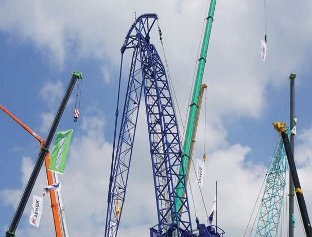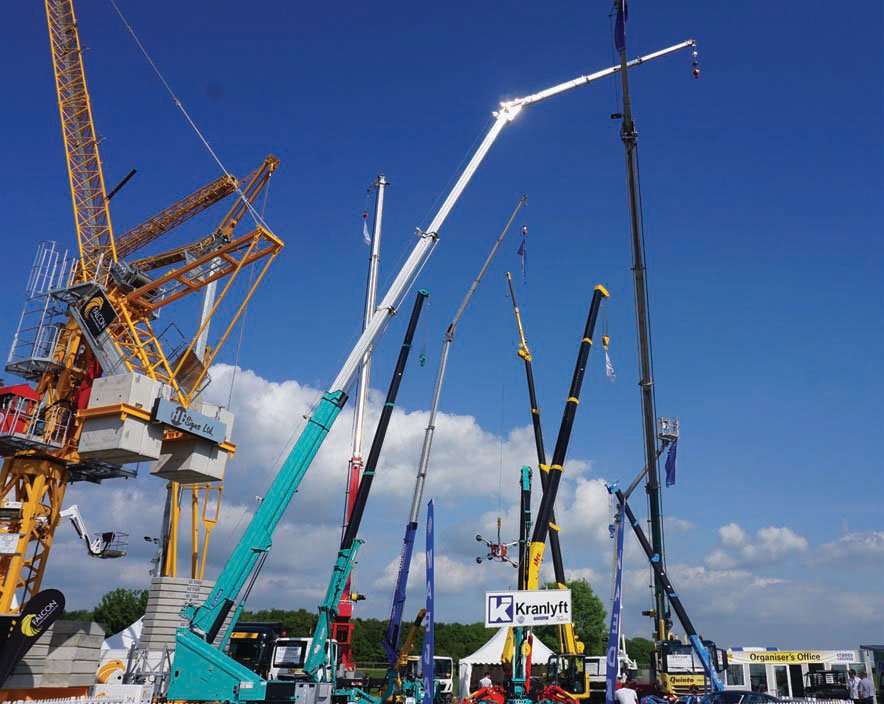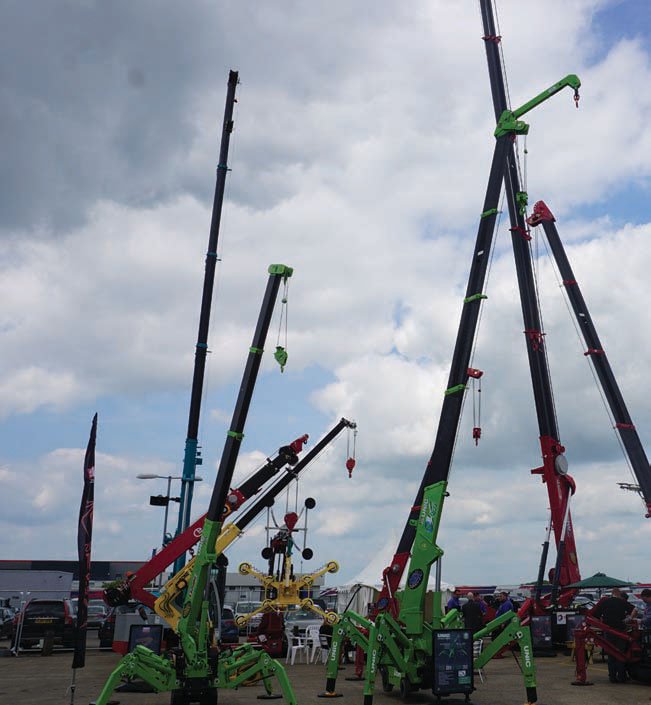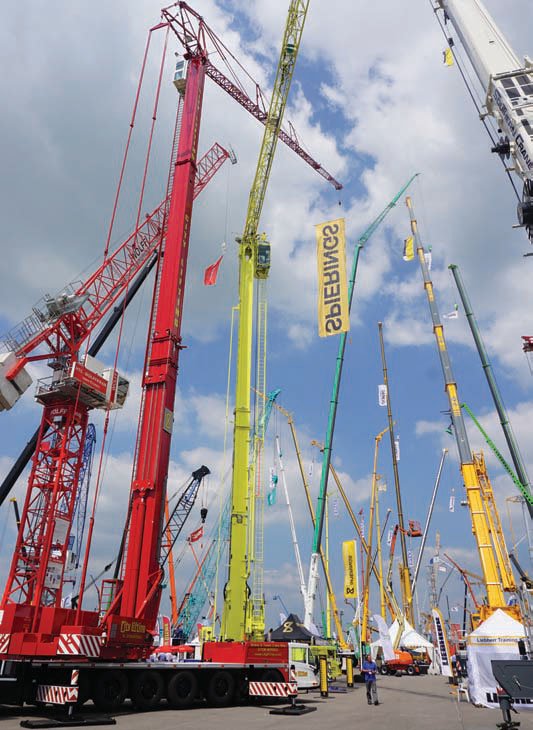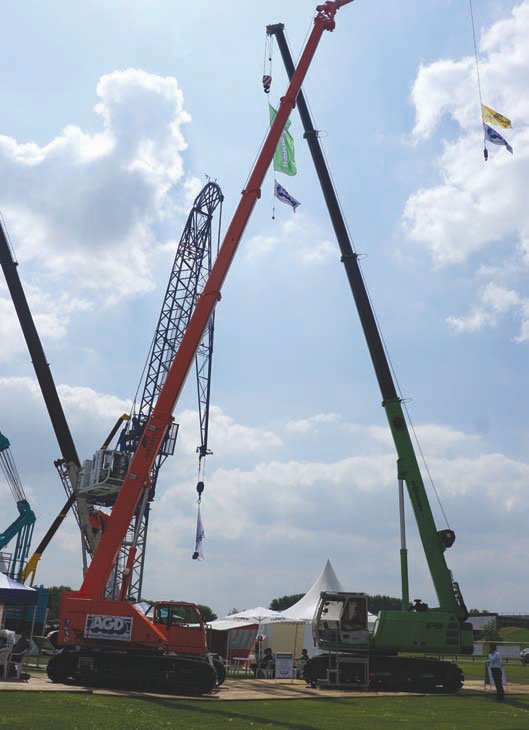Diffuse demand for UK cranes
17 August 2017Over recent years, the recovery in the UK lifting industry has been lead by London, with demand slower across the rest of the country. At Vertikal Days, crane dealers and users told Will North that the market is now more evenly spread across the country. However, exchange rates remain a concern for some.
When the UK market first began to pick up, many in the industry reported a two-speed economy of ‘London and the rest’.
Dave Rees, operations manager at crawler specialist NRC, says, “There’s not so much division [between London and the rest]. All the big cities now, are basically other Londons in terms of pricing and rates. There’s definitely not such a big divide. We certainly don’t get a premium just because a crane is going to London.”
This holds true as much for tower cranes as for crawlers, says HTC Wolffkran COO Duncan Salt. “We’re getting more work up and down the country. We always had a bit of a toe in Manchester, but we’ve now got the 166s up in Leeds, we’ve had a lot of work for saddlejibs and flat tops in Birmingham, and there’s more work coming through there.”
While demand may have spread across the country, growth is showing some sings of a new slowdown.
One factor in this is exchange rates. With the pound pummeled by uncertainty over the country’s vote to leave the EU, buying a crane has become more expensive.
Richard Everist, MD of Liebherr GB, says, “Inevitably, currency has a very strong impact on the market and on customers buying decisions. I’ve tracked the last ten years of the UK market for cranes and currency, and they trace virtually identical curves. Even knowing that there are other factors in there, you can’t get away from the fact that currency is the biggest.”
With all construction cranes sold in the UK built overseas, this is a cause for concern. Rees, whose company sells Link-Belt and Hitachi Sumitomo crawlers, says, “Post-Brexit, the exchange rate hasn’t really helped us with sales. Everyone’s got the same problem, but we’re dealing with Yen in Japan and Dollars in the US, two of the worst currencies.”
While the pound has regained some strength versus the Euro, it remains a concern for sellers of cranes built on the mainland. Andrew Plant, director of Tadano UK, says, “When Brexit happened, exchange rates dropped quite significantly. When the general election was announced, it went back up. It has an impact. It could be £20,000 on a crane.”
Rivertek relaunched Kato’s City Crane line in October 2015. This year was their second at Vertikal Days, and they brought their full range. MD Colin Cleary says, “Currency has been a factor. What we’re trying to do, with the factory in Japan, is to hold a high level of stock in Europe, so, if for example, there’s a demand, we can supply it at short notice and at the same time take advantage of currency highs and lows. If we see that the exchange rate is favourable, we will then order a consignment of cranes, so we can Finding your niche
One man who isn’t letting currency concerns cause him too much worry is City Lifting MD Trevor Jepson. He says, “I take the view that when you buy a crane, it costs what it costs. You buy it once, and then you get many years of use out of it.”
Jepson has built his business with a focus on the unusual demands of the London market: tight construction sites, limits on overflight of neighbouring properties, and high value developments.
He pushed Artic Cranes to launch the Raptor, the only articulated tower crane currently in production. As London’s high end residential sector continues to soar, many property owners and developers are finding a specific niche for these cranes.
Jepson explains, “London is an unusual market, it’s very difficult with the airspace problem. A lot of the jobs in the West End of London are in small, very high value, properties, with very narrow sites. You’re getting sites that are only 12 or 14m wide, but maybe 50m deep. The street looks quite beautiful from the front, but the buildings behind are falling down.
“What they are doing a lot now, is they put temporary steelwork up outside to retain the façade, and use the crane to demolish the whole building behind it. They then underpin the façade and adjoining properties, and build something new and architecturally marvellous inside.
“Because these sites are long and narrow, these Raptors are the only cranes that can do it. The out-of-service radius is 4.7m on the bigger crane, and 4m on the smaller, and you can also work the hook right up against the tower.
“You can get a 12m long piece of steel passed the crane, to the back of building. With some luffers, the minimum radius might be 6m, so on a job like this you are over the neighbouring property even at minimum radius. So, for small properties, these are ideal.”
Jepson has a keen eye for cranes that do a job few others can do: he’s been an early buyer of cranes from Spierings, Kato, Marchetti, and Böcker, all of whom had a presence at the show.
Rivertek’s Cleary has been pleased with the demand for the new CE-marked Kato City Cranes, for which there has been more than a decade of pent up demand. “The final older cranes sold in the UK would have been in 2002/3. Then there was a lull of 11 or 12 years, until 2015 when we took over the product.
“Initially, our focus was to relaunch them in Ireland and the UK, because these were the strongest markets for the brand traditionally.
At the moment, we have over 60 units sold, [with about 45 in the British Isles, and 15 on the European mainland]. Sales across the range have been very evenly spread out. Customers have been very happy with the machines. There’s been a certain pent up demand, due to the unavailability of these machines previously. Owners had kept on to their older machines a bit to long, so [replacement] has been a percentage of the sales as well.”
Since the relaunch, Cleary has seen repeat business, with companies including City Lifting and John Sutch coming back for more after their initial order. And, with sales in Germany and Spain, Rivertek has proved the machines can sell across the English Channel. Cleary says that Kato is dedicated to the European market, and will have more cranes to follow the three existing CE-marked models. “Currently we’re looking at newer models and newer markets. The mindset in Tokyo is that we’re in Europe to stay, to build the product range and build a customer base.
Their main factory, north of Tokyo, produces a range of cranes for Japan and export, from the 13t city crane all the way up to 300t and 400t all terrain cranes. The range we’ve introduced in Europe is specifically designed for Europe, but our intention is to introduce more models down the line. In Japan, they take three years to trial a crane. So, we’re looking to have new models in Europe in the next two-to-three years.”
Another new and unique entrant to the UK market is the aluminium boom truck-mounted crane of German manufacturer Böcker. These cranes are being sold in the UK by Kranlyft.
The range has been well supported by Neil Berry of Berry Cranes, who has som far bought nine. Other customers included market leading nationwide hire firm Ainscough, which has eight, City Lifting and ABA, who each have six, and Quinto, which has two.
Alexander Böcker says, “It’s a versatlie crane. Customers tell me they get three or four jobs a day from them. Of course, bigger cranes, can lift much more close to the crane. But, as the aluminium is lighter, you can lift 1t at a wider radius.”
Another innovative crane type Jepson has championed in London is the Spiering’s truck-mounted tower crane. With its ability to self erect and to slew over obstacles, this form of crane is ideal for many jobs in the city’s often medieval streets.
Leo Spierings, inventor of the concept and founder of the company, recently regained full ownership of the business. He’s looking to invest in new cranes, and new production. The most highly anticipated new model is the City Boy, which is now likely to launch at a company open day in October.
At the show, Spierings showed its most recent four-axle. Here, the firm has focused on bringing the power of a larger five-axle model to a more compact carrier.
Leo Spierings says, “The new fouraxle is a very good machine, with a very good radius. The old five-axle had also a 48m radius, so with the same jib length, it is easy to swap over. The rent is connected to the jib length. We’ve sold 100 units since Bauma.” Koos Spierings looks after sales of these cranes in the UK. He says, “Its still a very big [potential] market. We have around 70 machines in the UK at the moment, but there’s a market for 700: they just don’t know that yet, and we will tell them.
“More and more people see the benefits of this crane concept. Ainscough bought three six axles in the last two years. John Sutch and City Lifting are investing in new cranes, but also new companies are starting to see the benefits of these cranes and are getting requests for them from end users.
“We have a good spread with our machines. We have a fleet in Birmingham, around Liverpool there are quite a few machines, and in Scotland. So they are spreading over the country. “For every lift over 3t, it is in many situations the best solution. It is a lot easier to make a lift plan with our cranes. The outrigger pressure is not so high as a mobile telescopic crane. All our cranes come ready to go. That’s a very strong part of the crane concept, we did not just design the crane, we designed the complete package of a machine ready to work. In Holland they found that out, and there are 500 cranes there.”
Mini mart
Split between access and cranes, Vertikal Days has a strong presence of mini and compact cranes.
One such specialist is GGR, the European dealer for Japanese minicranes made by Unic, and the owner of a substantial UK rental fleet. Gill Riley, who founded the company with her brother Graeme, sees a bright future for the business.
A new 59,900 sq ft headquarters, with a ‘vast’ yard is at the heart of the company’s growth strategy. She says, “We’re having a proper training centre. Big rooms, small rooms, training rooms. It will have 10 training rooms and several training yards.”
The facility is 45 minutes from London, and a short walk from the local train station. As well as offering training in the UK CPCS’s A66 compact crane certification, GGR will offer training in tower cranes and other equipment.
The company is also expanding its equipment offering, with a new pick and carry crane on an excavator carrier, built at GGR’s requests by Chinese manufacturer Sunward. Riley says, “It’s turned out to be very reliable. They seem quite committed to coming into Europe. It’s a 5t pick and carry crane with a fixed boom. We’re trialling them: we have six in our hire fleet, we’ve said we are going to put them to work and make sure we are 100% happy.”
In the UK, the rental model used by GGR is common for small cranes. AGD’s Robert Law says, “[For small, compact, telecrawlers] we’re finding it largely a rental market, there’s not many end users buying them. We’re selling them to other rental companies, and we have them in our own rental fleet. It’s typical of the market trend. The odd construction company will buy one or two machines, but it certainly lends itself to a rental market.”
Some of the same factors that drive Jepson’s success with Raptors, are also driving the market for AGD’s Marchetti compact telecrawlers. “It’s driven by space. These days, sites are getting smaller and smaller. Land’s worth more, so it is worth developing a small piece of land where previously it might have been left.”
Kranlyft, which offers Maeda’ minicranes alongside its new Böckers, has also had recent successes. Its new MC815 minicrane has received a series of orders. Its 5t CC985 crawler is mounted on a new Maedabuilt carrier powered by a Tier IV Isuzu engine, with an eye to sites, particularly in London, that may demand compliance with tough emissions regulations.
Mobile call
While the show gave plenty of space to mini and compact equipment, there were also some very big cranes on display. Biggest of all was the new eight-axle Liebherr LTM 1450-8.1. The crane, launched at Bauma, offers a long boom and 450t lifting capacity, on a relatively compact and ready-to-work carrier. Liebherr’s Everist says that as well as wanting to show UK customers the company’s latest innovation, this model will be ideal for the country’s demand for high power in tight spaces, and more lenient weight restrictions.
“Although it can be run at 12t per axle in the European market, in the UK market [where cranes can run at 16.5t axle loads at normal speed, and even more at restricted travel speeds] it can run with 24t of counterweight at 15.5t per axle. It’s very economic to transport. It will do a lot of jobs with just one truck load. That’s ideal.
“It’s got VarioBase and VarioBallast, so the tailswing can be reduced to just 5m, which is really compact for a big crane. And there’s no Y-guy tailswing, as there’s no Y-guy.”
Everist, whose tracking of currency and crane sales indicates some potential weakness, says the rental market is broadly holding up. “Utilisation has been good, but is now a little softer. That will probably be detrimental to rental rates.
Tadano UK saw a boost in sales when it moved from family ownership to being a direct subsidiary of the Japanese headquarted manufacturer. The company’s growth was boosted by an initial surge of orders from Hewden, and rapidly soared from 15 orders a year to 68. Like Liebherr, the company saw the advantages of the UK’s travel rules, pushing engineers at Tadano Faun to redesign counterweight on their popular 220t machine to make the most of allowable axle weights.
With the failure of Hewden, and sell off of 140 cranes at auction, all UK all terrain dealers faced a challenge. Tadano UK though was stung by its own success. Plant says, “We had to take 14 cranes on a buy back. That’s also affected new sales, as we had to sell those. Six of those now have gone to Ainscough, [the first time for Tadano], so as one door shut, we’ve opened another one.”
Crawler sales too have been resilient. Kobelco’s Mark Evans says, “We’ve had a strong start to the year, with orders coming from a number of contractors and rental companies. Belden took four machines last year, and followed up with another four machines this year. We’ve got orders from one or two other companies coming through.”
Investment in major projects has seen some wobbles—such as the cancellation of a major railway electrification scheme—but is still a key source of demand.
Evans says, “You’ve got [London commuter service] Crossrail 2 about to start, and some of our customers are involved in the three enabling work packages that have been granted for [high speed rail project] HS2.” The company also recently announced orders linked to the construction of the Hinckley Point nuclear power plant (see news, this issue).
Standing tall
With investors around the world still looking to London high end property, the city’s skyline bristles with towers, often in the white of Select’s Terex Comedils or red of HTC Wolffkran, but with some recent splashes of Liebherr yellow, along with independents like Falcon and some Potains brought on dry hire by RadiusNFT.
While the London market doesn’t require quite the speed, height and power as New York, it is demanding. Wolff’s Salt says, “The 166 hydraulic luffer is great for concrete. For speed of operation, it luffs so much quicker than the old 180. When construction is steel or precast, we use the 355B.” As much as the cranes’ capabilities, Salt credits HTC Wolffkran’s staff and support for its success, pointing to its ability to get cranes ready to work quickly.
While Select and Wolffkran dominate, other major tower manufacturers eye the market eagerly. Liebherr’s Everist says, “With tower cranes, we’ve been quite open that we have a strategy to increase our market share. We won’t have a high market share, we will still be a relatively small player compared to HTC Wolffkran and Select, but we still want to increase what we do have. We’re doing that, either by selective sales, or more commonly with rental. We are known as being a premium product. Customers who want a premium product have a limited choice. That’s where we are finding doors opening.”
The UK market has undoubtedly been shaken by Brexit and its associated impact on exchange rates and confidence. However, sales and rental rates remain resilient, across crane types and across the country. As the economy reshapes itself to life outside the EU, and voters demand spending, there is room for growth
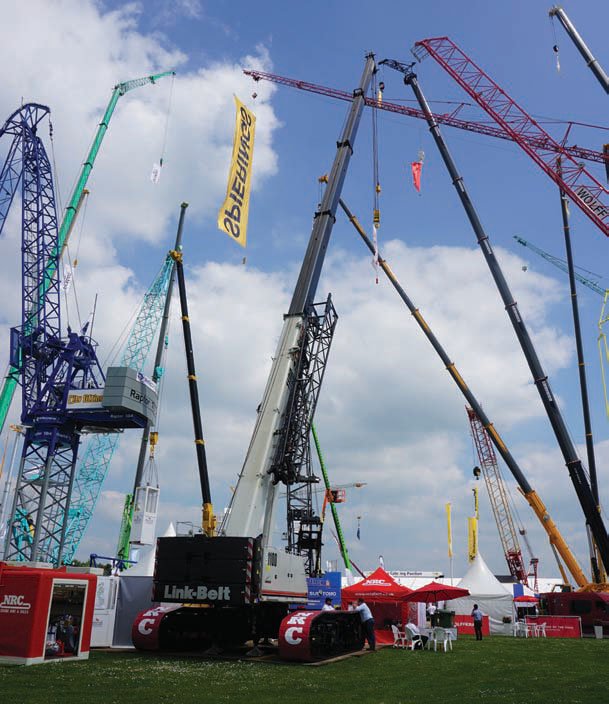 NRC brought Link-Belt’s new TCC 1100 to the show. Dave Rees says smaller telescopic boom cranes are the ‘bread and butter’ of the crawler market.
NRC brought Link-Belt’s new TCC 1100 to the show. Dave Rees says smaller telescopic boom cranes are the ‘bread and butter’ of the crawler market.
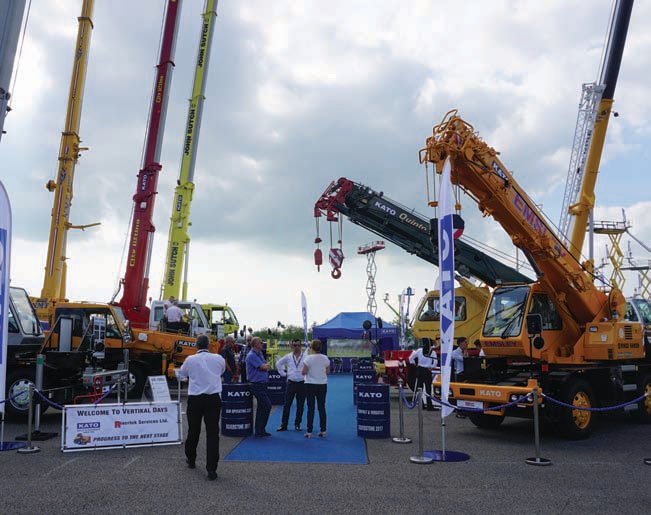 Rivertek relaunched the Kato City Crane range at Vertikal Days in 2016. This year, with sales progressing well, it brought the full range of CE-marked cranes.
Rivertek relaunched the Kato City Crane range at Vertikal Days in 2016. This year, with sales progressing well, it brought the full range of CE-marked cranes.
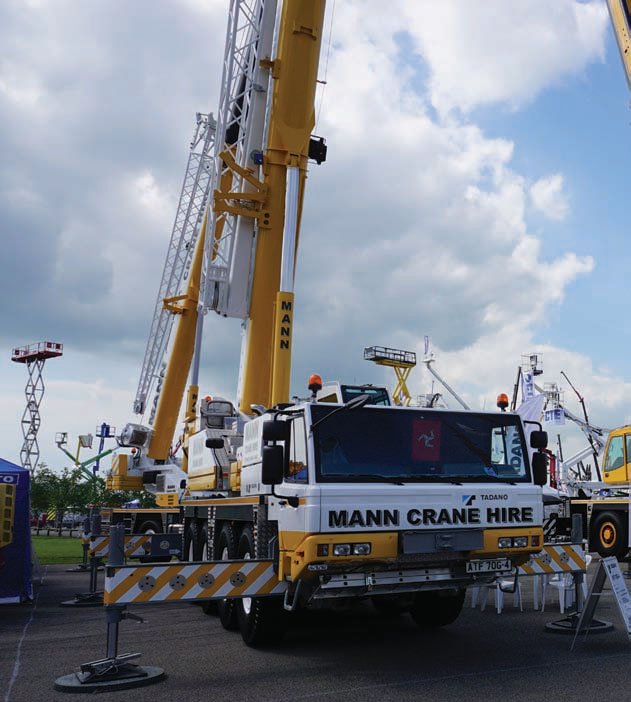 Tadano UK, now a directly owned subsidiary of the Japanese crane builder, has seen a boost in sales, supported by its parent company’s investment
Tadano UK, now a directly owned subsidiary of the Japanese crane builder, has seen a boost in sales, supported by its parent company’s investment
